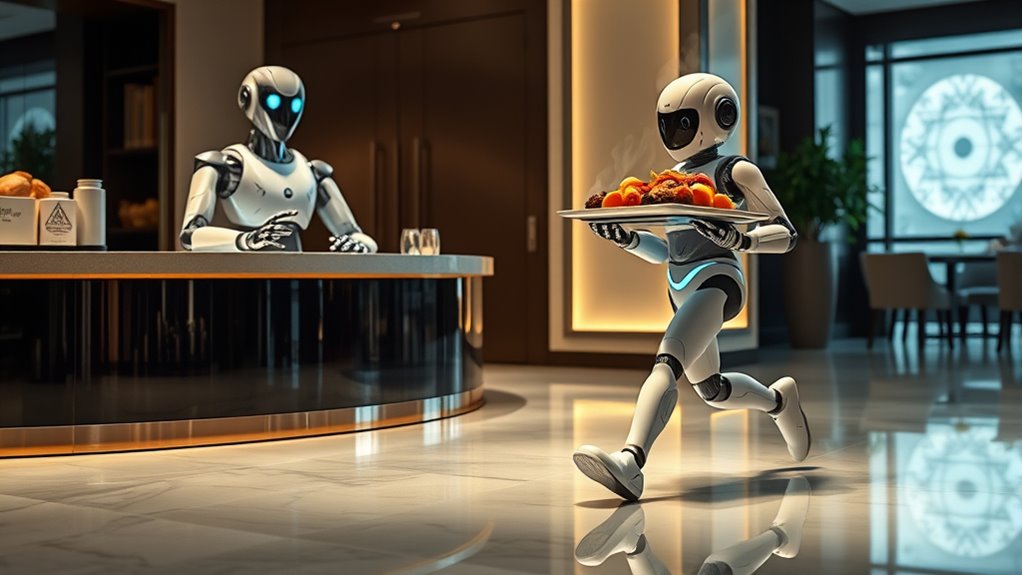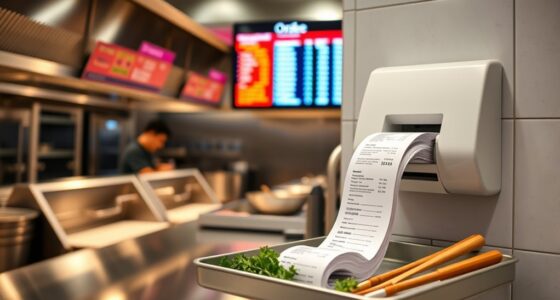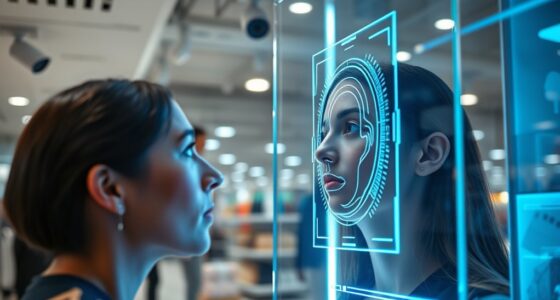Front‑of‑house robotics, like host and runner bots, are transforming restaurant service by boosting efficiency and reducing costs. Host robots greet guests, manage reservations, and guide them to tables, while runner bots deliver food and beverages quickly and accurately. These robots use sensors, AI, and voice recognition to navigate crowded spaces and interact seamlessly. If you keep exploring, you’ll discover how these innovations can enhance your establishment’s customer experience and streamline operations.
Key Takeaways
- Host robots greet guests, manage reservations, and guide them to tables, enhancing the dining experience with automation.
- Runner bots deliver food and drinks directly to tables, improving efficiency during busy periods.
- These robots utilize sensors, AI, and voice recognition for precise navigation and natural guest interactions.
- Challenges include navigation in crowded environments, system malfunctions, and guest acceptance issues.
- Future developments focus on intelligent, personalized robots and increased collaboration with staff to optimize service.
The Rise of Autonomous Host Robots in Restaurants
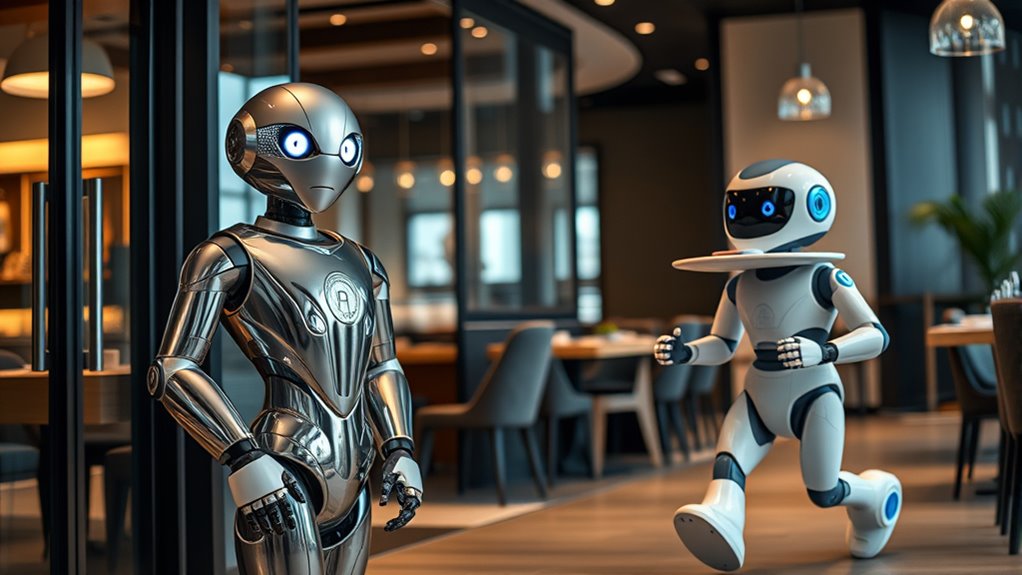
As restaurants seek to improve efficiency and reduce costs, autonomous host robots are increasingly taking on the role of greeting and seating guests. These robots use advanced sensors and AI to navigate the front-of-house seamlessly, recognizing returning customers and managing reservations automatically. They can greet guests with a friendly message and guide them to their tables without human intervention. This reduces wait times and streamlines the seating process. With their consistent performance, they eliminate human errors and ensure a smooth flow of guests. Additionally, they can operate during peak hours, freeing staff to focus on delivering personalized service elsewhere. As technology advances, these robots become more sophisticated, offering a modern touch that appeals to tech-savvy customers and enhances overall restaurant efficiency. Employing data-driven strategies can help optimize their deployment and improve guest satisfaction.
Key Functions of Runner Bots in Dining Establishments

Runner bots play a essential role in streamlining operations within dining establishments by efficiently delivering food, beverages, and other essentials directly to your table. They handle the task of transporting orders from the kitchen or bar, reducing wait times and freeing up staff to focus on customer service. These bots navigate seamlessly through crowded spaces, avoiding obstacles and ensuring timely deliveries. They can also carry multiple items simultaneously, increasing efficiency during busy hours. In addition, runner bots assist with refilling drinks, delivering condiments, or collecting used dishes, maintaining smooth flow throughout your dining experience. Their consistent performance minimizes errors and enhances overall service speed, creating a more efficient environment. By automating routine tasks, runner bots help improve customer satisfaction and operational productivity. Additionally, integrating digital platforms can optimize the coordination and management of these robotic services, further enhancing efficiency.
Benefits of Implementing Front‑of‑House Robots
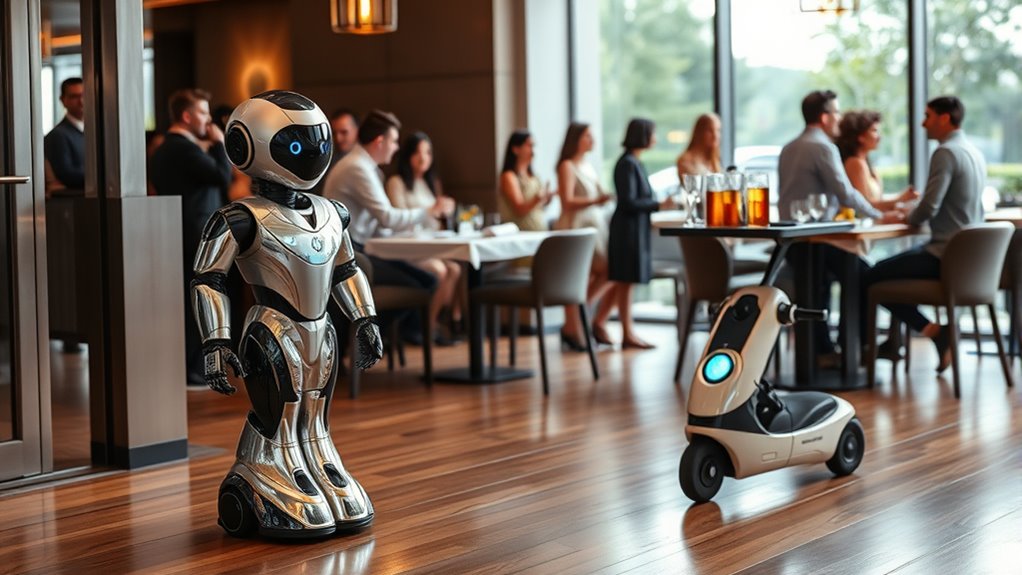
Implementing front-of-house robots offers a range of tangible benefits that can considerably improve your restaurant’s operations. These robots enhance efficiency by reducing wait times and streamlining service, allowing your staff to focus on delivering a more personalized guest experience. They also increase consistency, ensuring that orders are delivered accurately and promptly every time. Additionally, robots can operate during peak hours without fatigue, boosting overall throughput. They help cut labor costs by automating routine tasks, freeing your team to handle more complex customer needs. Moreover, incorporating robots can elevate your restaurant’s modern image, attracting tech-savvy customers and setting you apart from competitors. Furthermore, understanding support hours can help you plan maintenance and troubleshoot issues effectively, minimizing downtime. Overall, front-of-house robots improve service quality, operational efficiency, and customer satisfaction, making them a valuable investment for your establishment’s growth.
Technological Features Powering Hospitality Robots
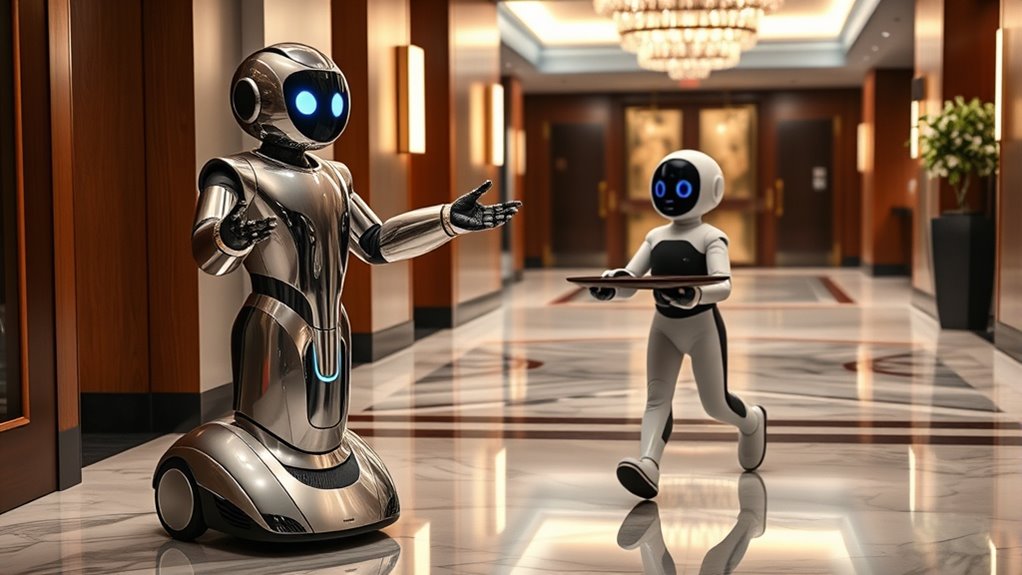
The advanced technological features powering hospitality robots combine hardware and software innovations to deliver seamless service. You’ll find sensors and cameras that help robots navigate busy environments accurately and avoid obstacles. AI algorithms enable them to understand and respond to guest requests quickly, adapting to different situations. Voice recognition technology allows for natural communication, making interactions feel more personal. Precise motor controls ensure smooth movements, whether delivering food or guiding guests. Connectivity features, like Wi-Fi and Bluetooth, keep robots linked to hotel systems for real-time updates. Battery management systems optimize operation time, reducing downtime. Incorporating color accuracy in sensors and displays can enhance visual interactions and information display, contributing to a more engaging guest experience. These integrated components work together to create efficient, reliable robots capable of handling multiple tasks, enhancing guest experience, and streamlining front-of-house operations.
Challenges and Limitations of Robotic Hosts and Runners
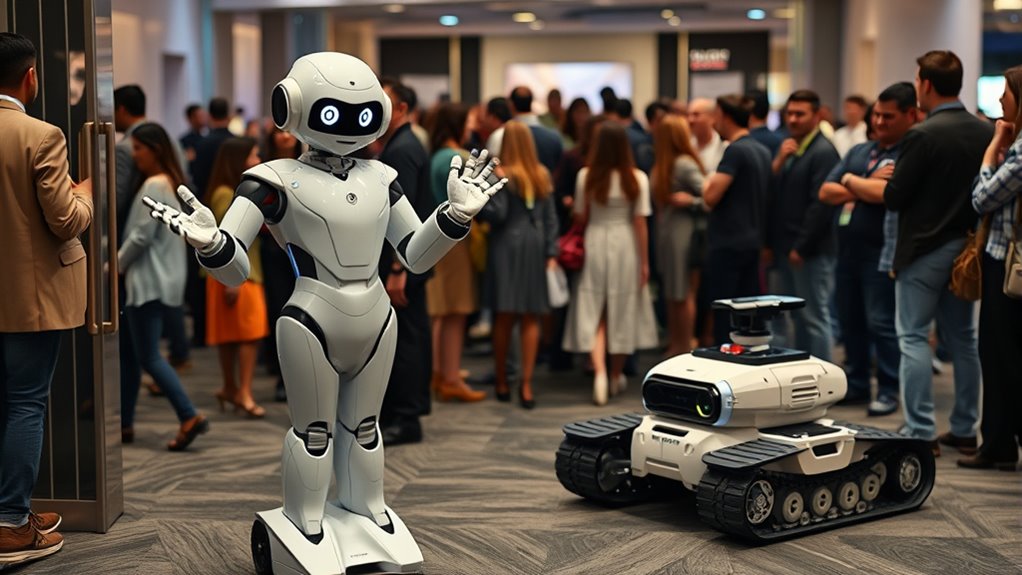
You might notice that robots often struggle to navigate crowded or complex spaces smoothly. Their limited social skills can make interactions feel less natural or warm. Plus, technical glitches or breakdowns can disrupt service and reduce trust in robotic hosts and runners. Additionally, the challenge of ensuring reliable custodian services for maintenance and security remains a significant hurdle for widespread adoption.
Navigating Complex Environments
Maneuvering complex environments remains a significant challenge for robotic hosts and runners, as they must constantly adapt to unpredictable obstacles and dynamic layouts. You’ll find that cluttered spaces, narrow pathways, and moving obstacles require real-time adjustments, which can overwhelm sensors and navigation algorithms. Lighting variations, reflective surfaces, and uneven floors further complicate perception, causing potential miscalculations. Sharp turns or sudden changes in layout demand quick, precise movements that are difficult to execute reliably. Limited field of view and sensor range can cause blind spots, increasing the risk of collisions. Additionally, environments that aren’t well-mapped or frequently changing pose ongoing navigation hurdles. These factors highlight the difficulty of ensuring smooth, safe movement in unpredictable, dynamic settings. Proper sensor calibration and environment mapping are essential to improve navigation accuracy and safety in such settings.
Limited Social Interaction Skills
While robotic hosts and runners have made strides in maneuvering complex environments, they still struggle with social interactions. They often lack the nuance needed to understand human emotions, tone, and context, making conversations feel robotic or awkward. This limits their ability to create genuine connections with guests, which is essential in hospitality settings. You might notice robotic hosts repeating scripted phrases or failing to respond appropriately to unexpected questions. Their inability to interpret social cues can lead to misunderstandings or frustration. As a result, they can’t replace the warmth and adaptability of human staff. These limitations highlight the importance of ongoing development to improve emotional intelligence and social responsiveness in robotic systems. Additionally, the current technology limitations restrict their capacity to fully replicate human-like social interactions.
Technical Reliability Concerns
Despite advancements, robotic hosts and runners frequently face technical reliability issues that hinder their effectiveness. You might experience unexpected malfunctions, such as navigation errors or sensor glitches, which disrupt service and frustrate guests. Software crashes or connectivity problems can cause bots to freeze or lose track of their tasks, leading to delays. Hardware failures, like battery issues or mechanical breakdowns, further reduce operational uptime. These reliability concerns mean you need constant maintenance and monitoring to guarantee smooth operation. Such challenges also limit scalability, as more robots increase the risk of technical failures. While technology continues to improve, reliability remains a significant hurdle, making it difficult to fully rely on bots without human oversight. Additionally, ongoing maintenance requirements are necessary to address these issues and ensure consistent performance. Overcoming these issues is vital for widespread adoption in front-of-house settings.
Case Studies of Robotic Integration in the Restaurant Industry
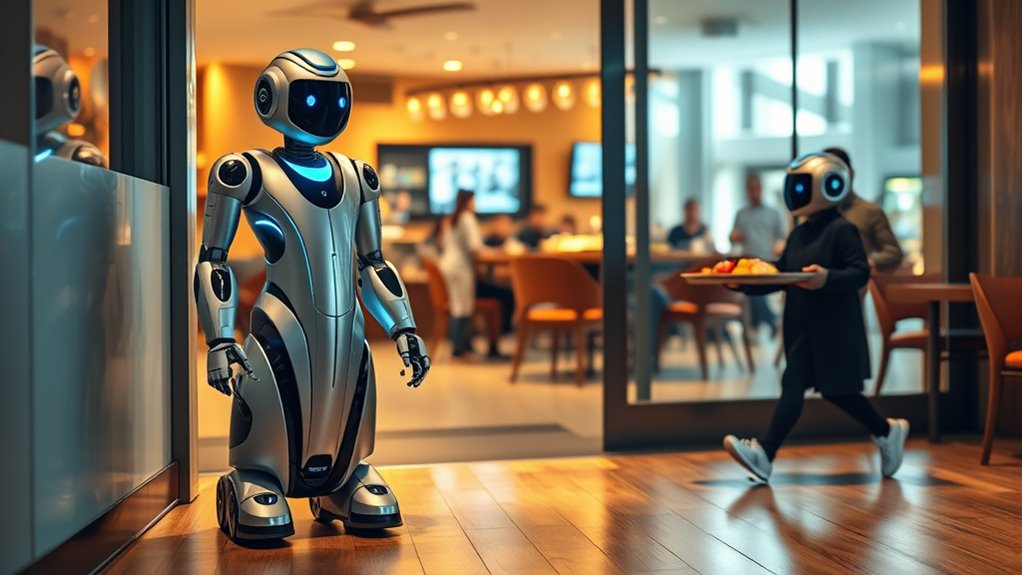
You’ll see how restaurants are using robots to boost service efficiency and improve guest experiences. These case studies highlight successful integrations, showing real benefits and outcomes. However, they also reveal challenges that come with implementing robotic solutions in busy dining environments. To optimize these innovations, understanding professional growth principles can help staff adapt to new technologies and maintain a positive attitude during transitions.
Robotics Enhancing Service Efficiency
Robotics are transforming the restaurant industry by considerably boosting service efficiency. By automating tasks like greeting guests, delivering orders, and managing reservations, robots free up staff to focus on personalized service. This streamlining reduces wait times and enhances overall guest experience. You’ll see how integration leads to smoother operations and better resource management.
- Reduces human error in order delivery and table management
- Speeds up service during peak hours
- Improves consistency in customer interactions
- Frees staff to handle complex or special requests
- Lowers operational costs over time
Embracing robotics means you can serve more guests efficiently while maintaining quality. It’s about creating a seamless, fast-paced environment that meets modern expectations without sacrificing hospitality.
Case Studies of Success
Several restaurants have already reaped the benefits of robotic integration, showcasing how these innovations can transform operations. For example, a fast-food chain reduced wait times by deploying host and runner bots, increasing customer turnover. Another success story involves a casual dining spot that improved service consistency with robots handling host duties during busy hours. These case studies highlight increased efficiency, satisfied customers, and reduced labor costs. Here’s a quick overview:
| Restaurant Type | Robot Function | Results |
|---|---|---|
| Fast-food chain | Host and runner bots | Faster service, higher turnover |
| Casual dining | Host bots | Consistent guest experience |
| Upscale restaurant | Automated seating | Reduced wait times, improved flow |
| Café | Delivery bots | Enhanced order accuracy, speed |
| Buffet | Guest assistance bots | Improved safety, cleaning efficiency |
Furthermore, the integration of robotic technology can lead to long-term cost savings and operational stability.
Challenges in Implementation
Implementing robots in restaurants often presents significant challenges, even when the technology shows promise. You might face issues with integration into existing workflows, staff training, and customer acceptance. Technical problems like navigation errors or malfunctions can disrupt service and frustrate guests. Cost is another hurdle; investing in robotic systems requires significant upfront capital, with uncertain ROI. Additionally, regulatory and safety concerns must be addressed to ensure compliance and protect both staff and customers. Resistance from employees hesitant to adapt to new technology can also slow down implementation.
- Resistance to change from staff and management
- Technical glitches that impact service quality
- High initial investment costs and unclear ROI
- Ensuring safety and regulatory compliance
- Customer acceptance and comfort levels
Future Trends in Hospitality Robotics
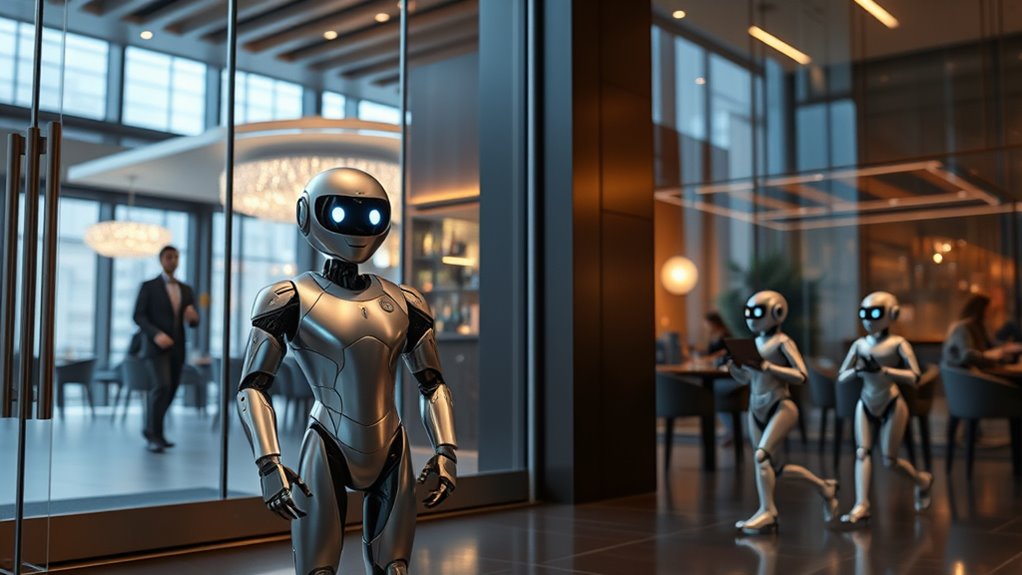
As technology continues to advance, the future of hospitality robotics promises to transform guest experiences and operational efficiency alike. Expect more intelligent robots capable of personalized interactions, making guests feel truly valued. Automation will expand beyond basic tasks, integrating AI-driven systems that predict needs and adapt in real-time. Hospitality venues might see robots that handle multiple functions, from greeting guests to managing inventory, reducing staff workload. Enhanced mobility and sensor technology will allow robots to navigate complex environments smoothly. Additionally, the rise of collaborative robots—cobots—will work alongside staff, increasing productivity while maintaining a human touch. As these trends develop, you’ll notice a seamless blend of technology and hospitality, creating more engaging, efficient, and safe experiences for your guests.
How to Choose the Right Robots for Your Restaurant
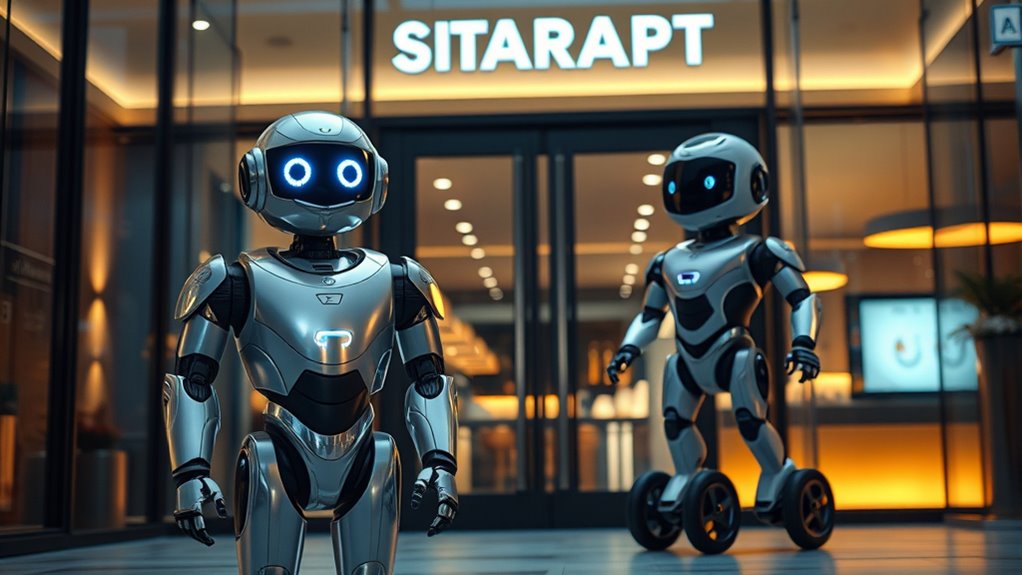
Choosing the right robots for your restaurant involves evaluating your specific operational needs and customer service goals. Think about what tasks you want robots to handle—whether greeting guests, delivering orders, or managing reservations. Consider the environment and space available, as some robots are better suited for tight areas or open layouts. Compatibility with your existing technology is key; guarantee they integrate smoothly with your systems. Budget constraints also matter, as costs vary widely. Lastly, evaluate the ease of use and maintenance to keep operations running efficiently.
Select robots that align with your restaurant’s needs, space, budget, and ease of integration for optimal customer service.
- Clarify your primary objectives to target the right robotic solutions
- Match robot design and functions to your restaurant layout
- Guarantee seamless integration with your current tech stack
- Balance cost with long-term value and support
- Prioritize user-friendliness and ease of maintenance
Frequently Asked Questions
How Do Robots Impact Customer Service Quality?
Robots can considerably impact customer service quality by providing faster, more efficient assistance and reducing wait times. You might find that they handle routine tasks reliably, freeing up staff to focus on personalized interactions. However, they can also lack the warmth and empathy of human staff, which might affect the overall experience. Ultimately, when used thoughtfully, robots enhance service consistency and operational efficiency, boosting customer satisfaction.
What Are the Safety Concerns With Hospitality Robots?
This issue is as critical as the safety of a diamond. You might worry about robots malfunctioning or causing accidents, which could lead to injuries or damage. You should guarantee proper maintenance, clear safety protocols, and staff training. Regular checks minimize risks, and designing robots with fail-safes helps protect both guests and staff. Staying proactive is essential to prevent mishaps and keep everyone safe in a dynamic hospitality environment.
Can Robotic Hosts Replace Human Staff Entirely?
You might wonder if robotic hosts can fully replace human staff. While robots can handle check-ins and guide guests efficiently, they lack the warmth and personal touch that guests often value. Plus, robots can’t handle complex issues or emotional interactions like humans do. So, it’s unlikely they’ll replace all staff entirely; instead, they’ll complement human roles, enhancing the guest experience without fully replacing human connection.
How Do Robots Handle Complex or Special Dietary Requests?
Imagine a robot handling a gluten-free, vegan, and spicy allergy request—it’s like a skilled chef juggling ingredients with precision. Robots can be programmed to recognize and process complex dietary needs through advanced AI and data systems. They follow detailed instructions, cross-check allergen info, and adapt quickly. While they excel at consistency, they still need human oversight for nuances and special requests that require empathy and judgment.
What Are the Long-Term Cost Implications of Robotic Deployment?
Considering the long-term cost implications of robotic deployment, you’ll find that initial investment can be high, but operational costs often decrease over time. Robots reduce labor expenses and increase efficiency, leading to savings. However, maintenance, updates, and potential replacements add ongoing costs. Overall, you should weigh these factors against productivity gains and customer satisfaction improvements to determine if robotic deployment offers a cost-effective solution for your business in the long run.
Conclusion
As you explore front-of-house robotics, remember that over 60% of restaurants plan to adopt automation within the next five years. Embracing host and runner bots can boost efficiency, enhance customer experience, and cut operational costs. While challenges exist, the benefits are clear. By choosing the right technology now, you position your restaurant at the forefront of innovation, ready to serve faster, smarter, and more personalized dining experiences that keep guests coming back.
